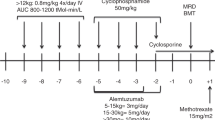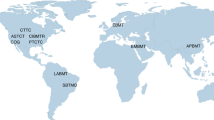Abstract
The development of reduced-intensity conditioning (RIC) and the success of BMT for paediatric sickle cell disease (SCD) have raised the possibility of revisiting this prospect in adults as well. In a chronic debilitating disorder managed with supportive therapy, the patients' perception is critical in the advancement of any potential curative therapy. To explore this aspect, we undertook a questionnaire-based survey on 30 adults with SCD. Sixty two per cent of the patients were ready to accept a transplant-related mortality (TRM) >10%; 30% of them a TRM >30%. A risk of graft failure (GF) >10% was acceptable to 64%, with a risk >30% acceptable to 41%. Infertility was acceptable to only 50%. Chronic graft-versus-host disease (GVHD) was unacceptable to the majority (80%). Seventy six per cent% of patients had a full sibling and 60% were willing to participate in a clinical trial of RIC transplantation. This survey suggests that the majority of adults with SCD might be willing to consider a curative option such as RIC transplantation even with a high TRM or GF. The major concerns relate to chronic GVHD and infertility. There is an urgent need to explore RIC transplants in SCD patients within the framework of a clinical trial, considering patient perception regarding cure and complications.
This is a preview of subscription content, access via your institution
Access options
Subscribe to this journal
Receive 12 print issues and online access
$259.00 per year
only $21.58 per issue
Buy this article
- Purchase on Springer Link
- Instant access to full article PDF
Prices may be subject to local taxes which are calculated during checkout


Similar content being viewed by others
References
Leikin SL, Gallagher D, Kinney TR, Sloane D, Klug P, Rida W . Mortality in children and adolescents with sickle cell disease. Cooperative Study of Sickle Cell Disease. Pediatrics 1989; 84: 500–508.
Platt OS, Brambilla DJ, Rosse WF, Milner PF, Castro O, Steinberg MH et al. Mortality in sickle cell disease. Life expectancy and risk factors for early death. N Engl J Med 1994; 330: 1639–1644.
Chakrabarti S, Bareford D . Will developments in allogeneic transplantation influence treatment of adult patients with sickle cell disease? Biol Blood Marrow Transplant 2004; 10: 23–31.
Vermylen C, Cornu G, Ferster A, Brichard B, Ninane J, Ferrant A et al. Haematopoietic stem cell transplantation for sickle cell anaemia: the first 50 patients transplanted in Belgium. Bone Marrow Transplant 1998; 22: 1–6.
Walters MC, Storb R, Patience M, Leisenring W, Taylor T, Sanders JE et al. Impact of bone marrow transplantation for symptomatic sickle cell disease: an interim report. Multicenter investigation of bone marrow transplantation for sickle cell disease. Blood 2000; 95: 1918–1924.
Kean LS, Durham MM, Adams AB, Hsu LL, Perry JR, Dillehay D et al. A cure for murine sickle cell disease through stable mixed chimerism and tolerance induction after nonmyeloablative conditioning and major histocompatibility complex-mismatched bone marrow transplantation. Blood 2002; 99: 1840–1849.
Chakrabarti S, Mackinnon S . The relevance of nonmyeloablative transplants in developing countries: lessons from the UK experience. Transplant Proc 2003; 35: 172–173.
Khouri IF, Keating M, Korbling M, Przepiorka D, Anderlini P, O'Brien S et al. Transplant-lite: induction of graft-versus-malignancy using fludarabine-based nonablative chemotherapy and allogeneic blood progenitor-cell transplantation as treatment for lymphoid malignancies. J Clin Oncol 1998; 16: 2817–2824.
Slavin S, Nagler A, Naparstek E, Kapelushnik Y, Aker M, Cividalli G et al. Nonmyeloablative stem cell transplantation and cell therapy as an alternative to conventional bone marrow transplantation with lethal cytoreduction for the treatment of malignant and nonmalignant hematologic diseases. Blood 1998; 91: 756–763.
Storb RF, Champlin R, Riddell SR, Murata M, Bryant S, Warren EH . Non-myeloablative transplants for malignant disease. Hematol Am Soc Hematol Educ Program 2001, 375–391.
Chakrabarti S, Handa SK, Bryon RJ, Griffiths MJ, Milligan DW . Will mixed chimerism cure autoimmune diseases after a nonmyeloablative stem cell transplant? Transplantation 2001; 72: 340–342.
Walters MC, Patience M, Leisenring W, Rogers ZR, Aquino VM, Buchanan GR et al. Stable mixed hematopoietic chimerism after bone marrow transplantation for sickle cell anemia. Biol Blood Marrow Transplant 2001; 7: 665–673.
Kodish E, Lantos J, Stocking C, Singer PA, Siegler M, Johnson FL . Bone marrow transplantation for sickle cell disease. A study of parents' decisions. N Engl J Med 1991; 325: 1349–1353.
van Besien K, Koshy M, Anderson-Shaw L, Talishy N, Dorn L, Devine S et al. Allogeneic stem cell transplantation for sickle cell disease. A study of patients decisions. Bone Marrow Transplant 2001; 28: 545–549.
Iannone R, Casella JF, Fuchs EJ, Chen AR, Jones RJ, Woolfrey A et al. Results of minimally toxic nonmyeloablative transplantation in patients with sickle cell anemia and beta-thalassemia. Biol Blood Marrow Transplant 2003; 9: 519–528.
Ohaeri JU, Shokunbi WA, Akinlade KS, Dare LO . The psychosocial problems of sickle cell disease sufferers and their methods of coping. Soc Sci Med 1995; 40: 955–960.
Perronne V, Roberts-Harewood M, Bachir D, Roudot-Thoraval F, Delord JM, Thuret I et al. Patterns of mortality in sickle cell disease in adults in France and England. Hematol J 2002; 3: 56–60.
Baron F, Maris MB, Sandmaier BM, Storer BE, Sorror M, Diaconescu R et al. Graft-versus-tumor effects after allogeneic hematopoietic cell transplantation with nonmyeloablative conditioning. J Clin Oncol 2005; 23: 1993–2003.
Lee SJ, Schover LR, Partridge AH, Patrizio P, Wallace WH, Hagerty K et al. American Society of Clinical Oncology recommendations on fertility preservation in cancer patients. J Clin Oncol 2006; 24: 2917–2931.
Brachet C, Azzi N, Demulder A, Devalck C, Gourdin A, Gulbis B et al. Hydroxyurea treatment for sickle cell disease: impact on haematopoietic stem cell transplantation's outcome. Bone Marrow Transplant 2004; 33: 799–803.
Teach SJ, Lillis KA, Grossi M . Compliance with penicillin prophylaxis in patients with sickle cell disease. Arch Pediatr Adolesc Med 1998; 152: 274–278.
Mentzer WC, Heller S, Pearle PR, Hackney E, Vichinsky E . Availability of related donors for bone marrow transplantation in sickle cell anemia. Am J Pediatr Hematol Oncol 1994; 16: 27–29.
Walters MC, Patience M, Leisenring W, Eckman JR, Buchanan GR, Rogers ZR et al. Barriers to bone marrow transplantation for sickle cell anemia. Biol Blood Marrow Transplant 1996; 2: 100–104.
Acknowledgements
We thank Dr Sudhir Tauro for his help in conducting this survey.
Author information
Authors and Affiliations
Corresponding author
Rights and permissions
About this article
Cite this article
Chakrabarti, S., Bareford, D. A survey on patient perception of reduced-intensity transplantation in adults with sickle cell disease. Bone Marrow Transplant 39, 447–451 (2007). https://doi.org/10.1038/sj.bmt.1705622
Received:
Revised:
Accepted:
Published:
Issue Date:
DOI: https://doi.org/10.1038/sj.bmt.1705622
Keywords
This article is cited by
-
Traffic Light: prognosis-based eligibility for clinical trials of hematopoietic SCT in adults with sickle cell anemia
Bone Marrow Transplantation (2015)
-
HLA-haploidentical blood or marrow transplantation with high-dose, post-transplantation cyclophosphamide
Bone Marrow Transplantation (2015)
-
Has stem cell transplantation come of age in the treatment of sickle cell disease?
Bone Marrow Transplantation (2007)



